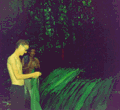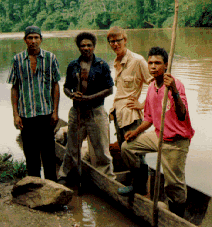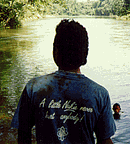ultimately, my guides taught me very little. there were times when i knew
they were talking about plants and places and directions and plans, in
miskito - i would ask them que paso sometimes, and recieve a largely
unintelligable answer in unenunciated crude spanish that would be repeated
with more emphasis if i "no intiendo"ed. i did learn to interpret some of
the "local folklore" i was supposed to be learning, but i felt like i
needed a guide for my guides.
more often i felt like i was sponsoring a trip for four guys. which was
alright, except they talked to each other all the time, and even about the
"miriki" (gringo in miskito, derived from "american"), but had not much to
say to me, except to marvel at my hardware (my nice flashlight, my nice
boots, my knife, my notebook, my pens). not the kind of learning
connection i hoped for, or that i was promised.
 at the same time, the lack of polished approach made this a trip closer to
the edge. literally, near the peak, swinging across ravines on fallen
trees, or climbing up rockface waterfalls using vines. there were no
shelters of any sort the second and third nights - we had to
cut poles and cut leaves and build lean-tos ourselves. this i did with my shirt off - i felt very manly and very cool.
at the same time, the lack of polished approach made this a trip closer to
the edge. literally, near the peak, swinging across ravines on fallen
trees, or climbing up rockface waterfalls using vines. there were no
shelters of any sort the second and third nights - we had to
cut poles and cut leaves and build lean-tos ourselves. this i did with my shirt off - i felt very manly and very cool.
but ultimately, the lack of professionalism, simple patience, was
discouraging, and at times dangerous. roy and rene would so seldom wait
for me, or even check to see where i was or what i was doing. i was made
aware of a venomous snake with large teeth that i'd just stepped over by
abran, who didn't want to step over it after me; not by roy or rene, who'd
already crossed over it safely. i was about to walk through a burgeoning
nest of matchstick length black ants reputed to have quite a mean bite,
roy and rene having proceeded ahead, but abran "cuidadoed" me.
razorgrass, my hands were cut, and trees with spikes on them, i grabbed
for balance yeilding bastante blood until i finally had to ask roy and
rene to start using the machete to cut back dangerous plants, and to warn
me when i could easily hurt myself. this they did only halfheartedly,
when they could stir themselves out of their own instinctive seeming
avoidance of dangerous stuff. maybe they didn't see it and i'm just
clumsy. either way they were rarely there to tell me anything, being more
than ten or twenty feet in front of me; paid by me to guide me, they did
little to discharge their responsibility.
perhaps this was a function of their youth. martin later told me that
rene was not yet a certified guide. las marias has over 86 certified
guides, and 16 more are in training. when the town has a collective
ecotourism enterprise, everyone wants a piece.
but not everyone can be guides - there wouldn't be that much steady work
unless the place is burgeoning with tourists, and more than 100 people are
just not qualified or proficient. so mopawi and the peace corps are
working with people in las marias to develop other industries; some of
which complement the tourism, some which sustain people through the gringo
dry-seasons. an example of the latter is cocoa
farms, interspersed with mahogany; both a long term and short term
investment.
while i was there, in the two hours before martin and i met, i was
approached by two other folks at my hospedaje. one person had a bag of
organic cacao from his own farm, another was selling a small model
pipante. mopawi has brought in experts from the rio patuca to train women here how to harvest the
tuno tree, and turn its bark-fabric into colourful cloth posters that sell
as la mosquitia souvenirs. from experience in las marias, when small
souvenirs or perhaps tools or other implements made from forest products
are available, people buy them.
visitors appreciate and want to help the tourism committee: the committee
has been collecting donations for just over two years now; enough that
they've almost completed construction of a visitors center. the idea
there is to solve a few of the information problems i ran up against -
collect pictures and warnings and maps and stories in one building where
tourists can go to look over the options and arrange their trips. also,
local artisans can vend their goods there as well.
each visitor leaving is asked to fill out a survey: how was their trip,
how much did they pay, what would they like to see for the future of las
marias. most all say they wish the guides had communicated a little
better with them, that more information on the forest region had been
available.
much of that information does not readily exist in las marias. how many
feet above sea level is pico dama? how many species of bird appear on the
river? what are the bird names in english? with lauri boxer and ethan
macomber of the peace corps, the committee is collecting these facts, and
hopes to provide pamphlets in town, and signs at the head of each trail.
they're even considering putting numbers along the trail itself, so that a
guide can have a printed information card and look things up; number 5 is
a good view of las marias, number 8 is a large fire ant hill.
i'm more in favour of better guide training, and leaving the trails
de-signified. the best kind of guide knows the dangers and the details
along the path, and can communicate these effectively to visitors. during
my four days, i got a taste of this kind of tour. my first day i went up
to see the petroglyphs at the same time as eight folks, two families, from
holland, led by a professional guide from puerto lempira, reputed in the
region, jorge salaverri. for a few hundred dollars more than what i paid,
he brings folks in from ceiba to las marias, with food, medical kits,
snike bite antidote and life jackets, and helps them trek, camp out, or
river raft. in this case, we were all paddling upriver to see these rock
carvings. about 2/3rds through, we met some rapids, a shallow part where
the guides prefered not to have extra weight in the boat, so jorge lead a
brief walking tour through the jungle.
it was as close to disneyland as i got in the jungle:
overweight white people walking slowly, and in the front of the group were
two kids, between 6 and 10, constantly bugging jorge about
everything. he displayed commendable patience. he waited for the
slow folks. he identified something every ten feet; a relative of the
pepper plant, wild cilantro, bark that makes a flavourful tea.
if that's value added service, i think i'd go for the value add. i
certainly wouldn't want to sacrifice the bare chested leaf lean-to
building, but i wouldn't want to traipse through that kind of nature
without learning about what's going on in some kind of concerted way. it
is an incredible classroom, given the right teacher. i was stuck trying
to vibe my way through it. fortunately the vibes are quite strong.
that is also reflected in the visitors surveys. while many bemoan the
lack of information, nearly all mark that they had a good or excellent
experience. the forest and river are just too stunning to be denied.
accordingly, many folks write that they hope it stays pristine - thomas
gahl, from germany, wrote in october of 1996, "Don't eat your forest."
agnes post, in august of 1995 wrote "Great place! We hope
it doesn't get like Costa Rica." (costa rica is the capital of
central american eco-tourism; in some parks you'll walk through rainforest
parks with as many as 15 or twenty other tourists, with hundreds more
lined up at the gate.)
one thing that might keep it raw is the difficulty of reaching las marias.
it's six or seven hours up the rio platano
from the coast to get there, walking, or by boat for almost $100 round
trip (which can be split between persons). las marias has been blessed
with little possible land for an airstrip - as a result planes only land
there in an emergency.
but if too many locals try to grab too large a piece of the visiting pie,
the resulting tourism could prove to be unsustainable. carlos molinero of
mopawi drew me up a graph - as soon as the prices become high enough,
people come expecting a higher level of services and facilities. if i'm
paying 100 lempiras a day for lodging, i'm not going to sleep in a plank
hewn bedroom with 10 people, i'm going to want privacy, and maybe a fan.
it's this kind of movement that pushes ecotourism into full-fledged
tourism. we might differentiate the two by the infrastructure; the
resources consumed by the community and the tourists, and the resulting
effect on the environment.
for example, ovidio, owner of the oldest hospedaje, secretary of the
ecotourism committee, and rene's father, is accelerating the pace of
change by expanding and individuating his hospedaje. instead of the
customary large room sleeping eight to twelve, he has two rooms, and is
building a third; each for three people. as a result, each room needs a
light, a door; more resources. accordingly, he wants to raise the
collective price to 40 lempiras a night, but the other folks in the town
are not ready to go along with it; some of the more "rustic" hostels do
not justify that rate.
as well, there is a problem with food in las marias - the people have
traditionally planted for small yeilds, barely enough for themselves.
anything beyond the basics is imported from the coast: six hours upriver
by pipante. legions of hungry hikers are not in the meal plan, and this
further strains the town's resources. for example, my trip was impactful
in part because i was not prepared. if i had brought in my own food, we
would have had no excuse to hunt, and i would not have been leeching off
the town's regularly depleted supply of basic foodstuffs.
as badly prepared as i was, the day after i returned, i ran into one
american and three brits travelling after teaching english to the upper
class of el salvador. they were leaving the next day for las marias, and
they wanted to make the exact trip i did - three nights, river and forest.
while they did have food, for four days of mud and water trudging three
had only sneakers. for the tropical jungle, they all had sleeping bags,
only one had a sleep sheet. none had water bottles. they asked me if
they could find boots there. they asked me how to say water bottle in
spanish; only one kind of spoke the language. to accomodate these
travellers, casual adventurers, las marias will need more infrastructure:
a place to rent boots, tents; a supply of food imported from the coast.
ethan and lauri of the peace corps, with help from mopawi, are working
with the committee to publish pamphlets to distribute at coastal
waystations en route to las marias, to let people know the kinds of things
they should bring with them to have an experience both more comfortable
and less demanding on the resources of the village.
while more demanding, these types of travellers end up giving more of
their money directly to the town. they pay in full for their hospitaje,
their guides, and perhaps in the future, for their supplies. that is
markedly different from most ecotourist operations, where the indigenous
people typically see under 10% of the foreign monies. fortunately,
they've held off that kind of business in las marias; one
group of foreigners started to build a hospedaje on the edge of town here,
and the people ran them out when they realized they wouldn't get a piece
of the action.
ecotourism is assumed to urge the community to place a value on sustaining
the pristinitity of their natural resources. peace corps volunteers plan
to start environmental education in for the children of the village next
year; explaining why the reserve needs to be protected, why the tourists
come.
while ecotourists demonstrate that maybe this forest stuff is important,
they add strain and encourage local consumpution. a lot rides on their
attitude. granted the lack of infrastructure, these early adventurers
have had to experience privation somewhere along the line, before they get
to las marias. now, many of the tourists who pay more and expect nicer
service are handled by tours that import for each adventure the food and
safety equipment to meet their expectations. while this lessens the
impact on the community, it often sends more money into the pockets of
foreign companies. fortunately, the committee system is established in
such a way that visitors can not avoid using guides from las marias to
visit the river, regardless of their supplies and safety.
there is an appropriate intermediate level, perhaps, where people are safe
and more comfortable, but the sacrifice in convenience is still
acknowledged as part of the experience. the most saught after commodity
now seems to be information.


